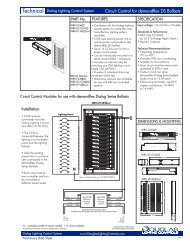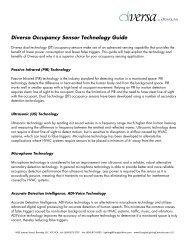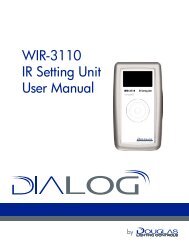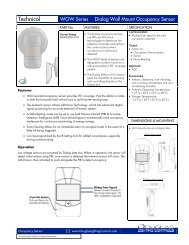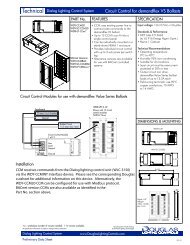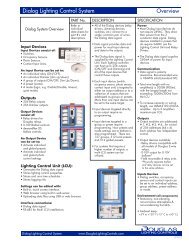noncondensing
Technical Data - Douglas Lighting Control
Technical Data - Douglas Lighting Control
- No tags were found...
You also want an ePaper? Increase the reach of your titles
YUMPU automatically turns print PDFs into web optimized ePapers that Google loves.
P<br />
Technical WOR Series Dialog Ceiling Occupancy Sensor<br />
Features<br />
PART No. FEATURES SPECIFICATION<br />
Standard Range<br />
WORSDG1-P-N<br />
Extended Range<br />
WORXDG1-P-N<br />
• The Dialog occupancy sensors use<br />
PIR and ADI-Voice technologies to<br />
determine the presence of people<br />
and perform the control actions when<br />
occupancy (or vacancy) is detected<br />
• The WOR Series of sensors are<br />
designed to mount recessed on a<br />
ceilings giving a 360° coverage<br />
pattern<br />
• The Dialog edition of this sensor<br />
gives the capability of operating and<br />
controlling directly on the Dialog bus<br />
• Recessed ceiling mounted occupancy sensor provides 360° coverage using an<br />
adjustable swivel head to maximize the sensor area.<br />
• The dual-tech sensor utilizes ADI-Voice Technology, which has advanced digital<br />
signal processing for accurate detection of human speech.<br />
• A Self-Adapting mode can be set to use both Passive Infrared (PIR) & Accurate<br />
Detection Intelligence (ADI) Voice technologies to automatically track occupancy<br />
tendencies for continuous maximizing of energy savings.<br />
• Smart Sensing allows for an immediate return to occupied mode in the event of a<br />
false off being triggered.<br />
• Programmed by the IR Setting Unit for added convenience, especially during<br />
commissioning.<br />
Communication<br />
• Dialog Data signal is the only<br />
connection required<br />
Output<br />
• Action on:<br />
• Occupancy/Unoccupancy<br />
• Switch<br />
• Photo Reading<br />
Approvals<br />
• FCC<br />
Environment<br />
• Indoors, stationary, non-vibrating,<br />
non-corrosive atmosphere and <strong>noncondensing</strong><br />
humidity<br />
• Ambient Operating Temperature:<br />
14°F to 140°F (-10°C to 60°C)<br />
• Storage Temperature:<br />
-14°F to 140°F (-25°C to 60°C)<br />
Operation<br />
Low voltage sensors are powered by the Dialog Bus. When in operation, the sensor will<br />
detect initial motion using PIR; once motion is detected the internal contact will close. The<br />
ADI-Voice is then activated to work alongside the PIR to detect occupancy.<br />
DIMENSIONS & MOUNTING<br />
• Unit attaches to mounting ring with<br />
screws or it can be mounted into an<br />
octagon box.<br />
• The WOR sensor will fit an octagon<br />
box. It is very important that<br />
conduits be attached at opposite<br />
ends of the box.<br />
• Use a 2-1/8” or more, deep box. If<br />
the box is less, use the spacer ring.<br />
Occupancy Sensor<br />
www.DouglasLightingControls.com<br />
R1.4<br />
Preliminary data subject to change without notice
P<br />
Coverage WOR Series Dialog Ceiling Occupancy Sensor<br />
INSTALLATION<br />
Installing in Smaller Room (Standard Lens)<br />
• Locate the sensor near the entrance door wall to prevent it from<br />
viewing out into the hallway.<br />
• The lens can rotate, allowing the sensor to be pointed toward the area<br />
in front of the entrance door.<br />
• Positioning the sensor in this manner ensures that an occupant moves<br />
across the longest detection beam upon entrance, utilizing the sensor's<br />
maximum PIR range.<br />
Standard Lens (S)<br />
• Optimal usage is to detect small<br />
motions such as hand movements<br />
• Designed for a mounting height of<br />
7-15ft<br />
• ADI-Voice can detect around<br />
corners that PIR cannot to maintain<br />
occupancy<br />
Typical Enclosed Office<br />
Extended Lens (X)<br />
• Optimal usage is to detect large<br />
motions such as walking<br />
• Designed for a mounting height of<br />
7-15ft<br />
• ADI-Voice can detect around<br />
corners that PIR cannot to maintain<br />
occupancy<br />
Installing in Larger Room (Extended Lens)<br />
• Place the sensor near the center of the room ceiling. Locate it so the<br />
approximate distance of 27ft in and over (A & B) or in dead center of<br />
room.<br />
• Tilt the lens to aim the detection zone to the bottom of the door. (C)<br />
• Positioning the sensor in this manner ensures that the beam does not<br />
reach outside the room without reducing sensitivity.<br />
Typical Classroom<br />
Occupancy Sensor<br />
www.DouglasLightingControls.com<br />
R1.4<br />
Preliminary data subject to change without notice
P<br />
Features WOR Series Dialog Ceiling Occupancy Sensor<br />
Wiring Instructions<br />
The WOR Series Low Voltage sensors are equipped with #18 AWG leads. Use appropriate sized wire-nuts to connect the wires to<br />
the incoming load terminations.<br />
Sensor Settings<br />
Programming - IR<br />
Programming can be done with the WIR-3110 setting unit. For more details and additional options please see the “IR Setting Unit Manual”<br />
Detection (Dual or PIR Only)<br />
When in operation, the sensor will detect initial motion using Passive Infrared; once motion is detected the ADI-Voice is then is activated to work<br />
alongside the PIR to maintain occupancy. The ADI-Voice can be disabled on any dual tech sensors.<br />
Automatic Timeout<br />
By setting the timeout dial to maximum, the sensor will be put into automatic mode which will adjust the time out automatically to maximize energy<br />
savings and occupant comfort.<br />
Smart Sensing<br />
When vacancy occurs, sensitivity of the ADI-Voice technology transitions from maximum to zero over an adaptively determined time period, based on<br />
occupancy tendencies. During this period, ADI-Voice can turn the lights back on immediately, even with no line-of-sight to the sensor, assuring the best<br />
combination of user convenience and energy savings.<br />
Energy consumption due to false triggers is minimized by the automatic walk-through mode. This feature turns the lights off after 3 minutes if no<br />
occupancy detection occurs in the first 30 seconds after initial turn on.<br />
Vacancy Mode<br />
The low voltage sensor can be selected as a vacancy (Off only) sensor. This provides additional energy savings by forcing the user to turn the lights on<br />
manually. The low voltage sensor has a built-in override input; allowing for the sensor to be operated as a vacancy sensor. For two pole sensors, it<br />
provides multi-level control capability.<br />
Photo Sensing (-P)<br />
When enabled, occupancy alone will not trigger the output state to on. If occupancy is detected AND there is a deficiency of natural light, the output<br />
is triggered on. An increase in natural light will not force the lights off but as the ambient light level drops the lights will turn on automatically. This<br />
feature will also limit the manual switching, ensuring the lights are not turned on if adequate light is present.<br />
Profile<br />
The Dialog sensor exists as three profiles in the system: a Switch, a Photocell, and an Occupancy Sensor. Each profile element can<br />
control separate control targets.<br />
Summary of Configuration Options<br />
Each building is unique in its lighting needs. Dialog sensors provide the user with a wide variety of configuration<br />
options to ensure each building’s individual needs are met.<br />
• Timeout 30 sec - 30 min or self adapting<br />
• Adjustable PIR Sensitivity<br />
• Adjustable Detect Intelligence Voice (ADI-Voice) Sensitivity<br />
• Enable/Disable ADI-Voice<br />
• Enable/Disable LED Indicators<br />
• Enable/Disable Walk Through Mode<br />
• Set parameters for light level setting upon occupancy detection<br />
* Application and Performance Specification Information Subject to Change without Notification<br />
Occupancy Sensor<br />
www.DouglasLightingControls.com<br />
R1.4<br />
Preliminary data subject to change without notice






